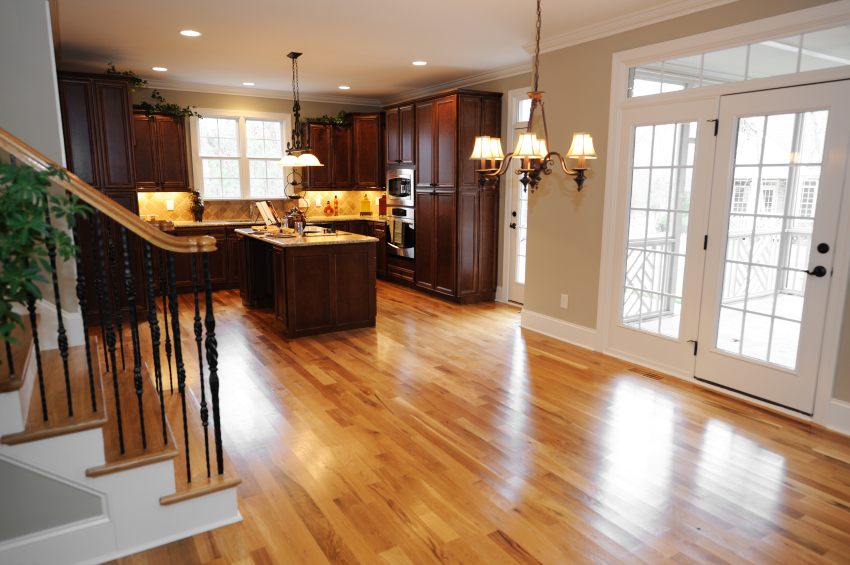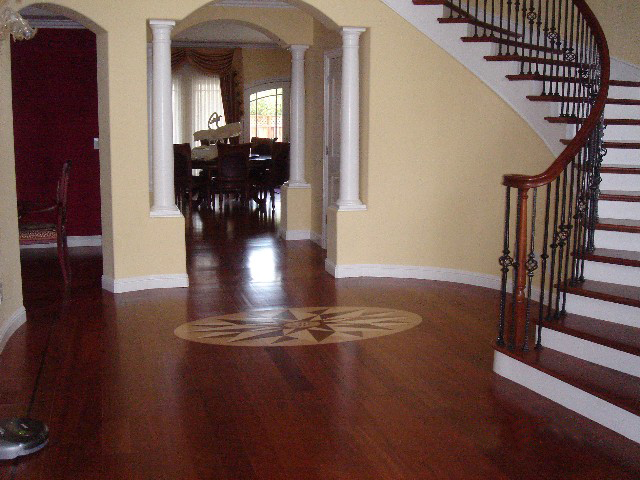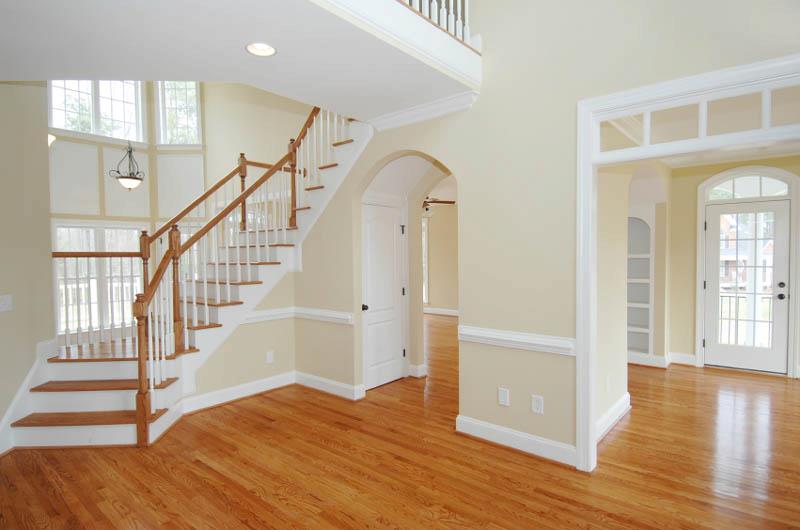
Whether you’re planning to install a new hardwood floor or just want to maintain the one you have, there are several things you need to know. Photo: Kyvos Construction Inc. ©2019
There’s a reason hardwood flooring has become an industry all its own—it’s a complex and challenging trade that requires an extensive amount of expertise. Accordingly, whether you’re planning to install a new hardwood floor or just want to maintain the one you have, there are a lot of things you need to know. To give you some insight, we asked 10 Diamond Certified Expert Contributors to provide their tips about hardwood flooring selection, design, installation and maintenance.
Choosing a hardwood flooring product
When selecting a hardwood flooring product, the most significant choice you’ll make is deciding between natural and engineered hardwood. Natural hardwood flooring is exactly what its name implies: solid wood that hasn’t been altered from its original state. Engineered hardwood flooring, on the other hand, is constructed with a core of plywood and a layer of natural wood on the top. Each of these products has specific pros and cons that you should know about before making your choice.
Natural Wood Flooring: Pros
Longevity: “The main thing that makes solid hardwood a great long-term choice is its extensive lifespan,” says Calvin Hoang, owner of C H Hardwood Floors in San Jose. “Even at 50 or 60 years old, many solid hardwood floors are still going strong, and some have even passed the century mark. Since natural hardwood can be refinished multiple times, it’s easy to refurbish a floor that’s in poor condition and make it look new again.”
Customization: Since natural hardwood floors are finished onsite, they allow for greater customization with design. For example, Bryan Keding of Floor Coverings International in Concord says you can choose any type of stain or finish you want. Furthermore, if you want to change the look of your floor in the future, all you need to do is refinish it.
Natural Wood Flooring: Cons
Installation limitations: Despite its durability, natural hardwood flooring isn’t a practical choice for all circumstances. “When considering natural hardwood flooring, it’s important to assess the specific conditions in your home—otherwise, you may run into problems following installation,” says Rick Stein, co-owner of Just Remnants in San Rafael. “One important thing to look at is the condition of the subfloor. More so than carpet, hard surface flooring requires a fairly level subfloor, so this needs to be assessed prior to installation. Additionally, excessive humidity levels and other moisture-related issues in the home can have negative long-term effects on hard surface flooring.”
Short finish lifespan: Another disadvantage of natural hardwood flooring is the short lifespan of its finish. “A natural wood floor’s polyurethane finish lasts seven to 10 years on average, which means it’ll likely need to be refinished within a decade of installation,” says Mr. Keding. “This process isn’t as easy as most homeowners think—it generally takes three to four days to complete and includes moving all furniture that’s on the floor. This need for recurrent refinishing substantially raises the long-term cost of owning a site-finished hardwood floor.”
Engineered Wood Flooring: Pros
Versatility/ease of installation: Since engineered wood floors are more moisture-resistant than solid hardwood, they work well in virtually any region of the Bay Area. Additionally, Kevin McCaffrey of Armstrong Carpet & Linoleum Co. in San Francisco points out that they can be installed using a variety of techniques. Whereas a natural hardwood floor typically needs to be nailed down, an engineered wood floor can be floated, nailed, glued, stapled or installed over an acoustical pad.
Durable finish: Whereas natural hardwood is finished onsite, engineered hardwood flooring is finished at the factory. This allows manufacturers to employ more intensive finishing techniques, which results in a more heavy-duty finish. “Today, most manufacturers use aluminum oxide, an extremely hard substance that, while not totally scratch-proof, is far more resilient than polyurethane,” explains Mr. Keding. “Once the floor is installed, there’s no need for future refinishing.”
Engineered Wood Flooring: Cons
Limited customization: Since engineered wood flooring is prefinished at the factory, homeowners don’t have the option to apply custom stains or finishes. Fortunately, Mr. McCaffrey says there’s still a wide array of colors and textures available, so you can find a product that best matches your home environment.
Limited refinishing: “Since engineered hardwood flooring only has a small layer of real wood on top, it can only be refinished once or twice at most,” explains Mr. Hoang. “After that, if the condition of the floor declines, the only option is to replace it, which is far more costly than refinishing.”

In many cases, design-related aspects like color and finish have practical effects that go beyond mere aesthetics. Photo: C H Hardwood Floors ©2019
Hardwood Floor Design Considerations
Other considerations when choosing a hardwood flooring product are design-related aspects such as color, finish and style. Many homeowners don’t realize these attributes can have effects that go far beyond mere aesthetics. For example, as Gary Jones of Jones Floor Designs in Antioch points out, the tint and finish of your hardwood floor can directly affect frequency of cleaning. “Darker wood floors tend to show dirt more than lighter floors,” he says. “Furthermore, whereas a glossy finish highlights dirt and imperfections, a satin finish produces more of a matte effect.” In homes that get a lot of foot traffic, these slight differences can have a potentially big impact.
Speaking of homes with high foot traffic, Dan Yorke of Danville Hardwood Company Incorporated recommends a flooring style that works well in this type of environment. “If you have an active household, consider a flooring style that will hide marks and other signs of wear, such as a distressed wood floor. Since distressed wood is intentionally given a worn aesthetic, wear and tear will enhance its character rather than diminish it.”
Mr. Yorke cites another design-related factor to consider when choosing hardwood flooring: plank size. “The width and length of the flooring planks you choose can have a surprising impact on your home’s visual aspect. Longer planks can add length to your home, while wide planks go well with an open concept floor plan.”
Installing a Natural Hardwood Floor
Whereas engineered hardwood flooring is typically easy to work with, installing a natural hardwood floor can be challenging, which is why it’s best to hire an experienced installer. “When installing a hardwood floor, proper procedure is critical,” affirms Nikolaos Margaritis, president of Kyvos Construction Inc. in Pittsburg. “For instance, the subfloor must be properly prepared. Any previous flooring materials need to be completely removed to make way for the incoming floor, including things like nails and staples. If the previous floor was glued down, this may make preparation more difficult and time-consuming.”
Another aspect of installing a natural hardwood floor happens long before the work begins. “The flooring materials should be delivered to the home a minimum of seven days before installation,” explains Mike Goldberg, owner of Lawrence Flooring & Interiors in Campbell. “This advance introduction to the home environment gives the moisture in the wood a chance to acclimate, or ‘warm up,’ to the new climate conditions, which helps avoid future issues like squeaking and cracking or separation. During the acclimation period, the home’s temperature should be kept at a steady 68 to 75 degrees to ensure thorough acclimation. Prior to installation, the wood should be checked by the installer to make sure it has fully adapted to the home’s climate.”

From regular cleaning to period refinishing, hardwood flooring requires a substantial amount of maintenance. Photo: Kyvos Construction Inc. ©2019
Hardwood Floor Maintenance
Whether you have natural or engineered hardwood floors, ongoing maintenance is crucial to maximize longevity and performance. Here are a couple of important aspects:
Hardwood Floor Cleaning
According to Roy Nelson, owner of Roy’s Woodcraft Flooring, Inc. in San Jose, the biggest mistake homeowners make when cleaning their hardwood floors is using the wrong kind of cleaning product. “Cleaners labeled as ‘finish revitalizers’ or that claim to ‘bring back that old shine’ typically contain some kind of oil or wax component, which are considered contaminants by flooring professionals,” he explains. “When you use this kind of product to clean your floors, these contaminants can become permanently embedded in the flooring. This can make refinishing impossible, as the presence of contaminants will inhibit a proper adhesive bond between the finish and the floor.”
To avoid this situation, it’s important to do some research and find a cleaning product that’s compatible with your floor’s finish. “There are three major finishes used on hardwood floors: urethane, UV oil and oil-based,” advises Mr. Yorke. “Urethane is the most low-maintenance of the three—for cleaning, Bona® Hardwood Floor Cleaner is a good choice. UV oil and oil-based finishes require cleaning products that are compatible with their oil-based composition. To get the best results, choose a kit that includes a natural cleaner safe for oil-based flooring, as well as one or more oil refreshing/rejuvenating products. Ideally, you should choose a cleaning kit made by your flooring product’s manufacturer—that way, there’s no question whether it’s appropriate.”
Repairing Hardwood Floor Damage
One great thing about wood floors is that most types of damage can be repaired by refinishing. However, according to Jason Stergion of Just Hardwood Floors in Cameron Park, attempting to refinish an isolated area of flooring can get complicated. “What makes spot refinishing a hardwood floor so challenging is the compositional differences between new and old finish,” he explains. “As finish ages, its complexion changes, usually by yellowing a bit. While this change may not be particularly noticeable, once you refinish an isolated section of the floor, the difference will be quite apparent. Since the new finish hasn’t aged like the floor’s existing finish, the refinished area will look lighter than the rest of the floor.”
In such situations, Mr. Stergion recommends refinishing the floor in its entirety to ensure a uniform aesthetic. “You may even consider refinishing the flooring in the adjoining rooms as well. This will ensure your hardwood floor has a consistent look and sheen throughout.”
Find a Diamond Certified hardwood flooring showroom, installer or repair technician in your area.
